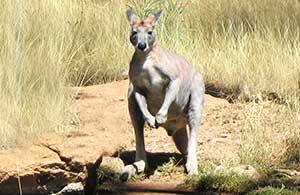Photo: Antilopine Kangaroo standing
Antilopine kangaroo has a slender face and doe-like eyes. It is the only kangaroo that lives entirely in the tropics. The antilopine kangaroo is a herbivorous marsupial macropod.
Because of its size, it is some times referred to as an Antilopine Wallaroo or Antilopine Wallaby.
Antilopine kangaroo's scientific name is Macropus antilopinus which translates to 'antelope-like long-foot'.
Antilopine Kangaroo Description What Does a Antilopine Kangaroo Look Like?
The antilopine kangaroo has a triangular-shaped body with large, powerful hind legs and feet and a large solid tail. Its limbs are more slender and proportionally longer than other types of kangaroos. The male antilopine kangaroo is reddish-tan in colour with a lighter coloured underside, about 1.2 meters tall, and weighs up to 49kgs. The male has a well-defined bulge above its nostrils; its function is not fully understood but may be for cooling. The female is usually grey in colour with a lighter coloured underside,about .8m tall, and weighs up to 20kg.
Antilopine kangaroos are relatively social, with loose-knit groups of up to 30 animals. Older males, however, tend to be solitary animals. A group of kangaroos is referred to as a 'mob of kangaroos’. An antilopine kangaroo has a lifespan of 14- 17 years.
Antilopine Kangaroo Specialised Adoptions How Antilopine Kangaroos Stay Cool

Photo: Antilopine Kangaroo in outback
The antilopine kangaroo has several special adaptations for dealing with its environment.
The antilopine kangaroo is mainly crepuscular. That is, it is active at dawn, dusk and into the night. It rarely moves about during the day.
During the day, it resides in shaded wooded areas to avoid the hot sun.
It has larger nasal passages to moisten and cool the hot air it breathes in. Like other kangaroos, the antilopine kangaroo sweats only while moving. And also spreads saliva on its forearms for cooling.
Antilopine Kangaroo Habitat & Distribution Where Do Antilopine Kangaroos Live?
Photo: Antilopine distribution map
The antilopine kangaroo lives in tropical savannah woodlands in the northern parts of Australia from the Kimberley to the Gulf of Carpentaria Another another population located in central-north Cape York. Antilopine kangaroos prefer flat or gently undulating terrain below 500m above sea level, where there is grass beneath the forest canopy with permanent water close by.
Antilopine kangaroos are not territorial moving from place to place as food becomes available. The male has a home range of approximately 100 hectare and the female has a smaller range of about 20 hectares.
Antilopine Kangaroo Diet What Do Antilopine Kangaroos Eat?
Antilopine Kangaroos eat short green grasses, such as low tussock grass, or the green shoots of long grasses burnt by bushfires. They are herbivorous.
The Antilopine Kangaroo uses its large outward projecting front incisor teeth on the lower jaw to slice through grass and leaves and its large molars at the back of its mouth chop and grinds its food. It spends 43.5% of each day in searching for food grazing and chewing.
Like all other kangaroos, the antilopine kangaroo has a two-chambered stomach: the sacciform and the tubiform. Chewed food is passed into the sacciform where bacteria, fungi and protozoa begin the fermentation so that the kangaroo can extract nutrients from its high cellulose diet. Once the food is well fermented, it is passed on to the tubiform where stomach acids and enzymes further break down the food before nutrients and water are extracted. The antilopine kangaroo extracts most of the water it requires from moisture in the food it eats and can go without drinking for long periods.
Antilopine Kangaroo Reproduction Baby Kangaroo (Joey)
Photo: Kangaroo baby crawling to mother's pouch
Like all kangaroos, the antilopine kangaroo's reproductive cycle is extraordinary. While the female can give birth to only one offspring at a time; it can be nurturing young in three different stages of development at the same time and even producing milk of different compositions in different teats for these babies. In other mammals, all the offspring of a litter are of the same age.
Antilopine Kangaroos can breed all year long, the peak period being during the wet season. Females give birth to one young at a time.
Usually, a neonate emerges 35 days after mating and makes its ways into its mother's pouch where it develops for another 140 days before it emerges from its pouch and starts to explore the world outside. It will still suckle from its mother until it is about 15 months old.
Antilopine Kangaroo Predators and Threats What Kills Antilopine Kangaroo?
Being large animals with powerful clawed feet, adult antilopine kangaroos do not have natural predators. The major causes of antilopine kangaroo fatalities are bushfires, and grazing by livestock and feral herbivores, which decrease the supply of grasses available for these animals.
Antilopine Kangaroo Conservation Status Is the Kangaroo Endangered?
Antilopine kangaroos are relatively common. Their exact numbers are not known. It is not endangered and classified as "least concern" by the IUCN, but it is protected animal.
All Rights Reserved. (Last Updated: Feb 02, 2022)